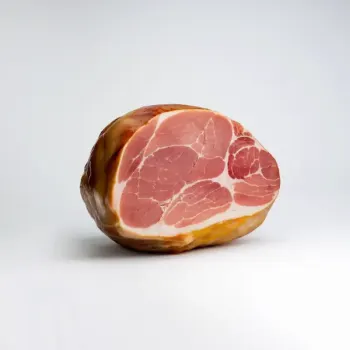Ham and Prosciutto are both cured pork products with distinct textures and flavors, used in various culinary applications from sandwiches and charcuterie boards to cooking, each bringing unique taste profiles to dishes.

Ham is a cut of pork that comes from the hind leg of the pig and is preserved through curing, smoking, or wet brining. It's known for its moist texture and can range from subtle to strong flavors depending on the preparation.

Prosciutto, specifically Prosciutto crudo, is an Italian dry-cured ham that is typically thinly sliced and served uncooked. It offers a complex balance of sweetness and saltiness, with a silky, melt-in-your-mouth texture.
Ham is often cooked or smoked and has a firmer texture, while Prosciutto is uncooked and air-dried, resulting in a delicate texture. Ham can be sweet to savory, whereas Prosciutto has a distinct, mature salty flavor. Their curing processes also differ, with Ham often being wet-cured and Prosciutto dry-cured.

Your ultimate Recipe Box, Meal Planner, and Cooking Class all in one
Ideal for a classic ham and cheese sandwich, providing a satisfying chew and a balanced flavor that doesn't overwhelm other ingredients. Perfect with whole grain mustard and a robust cheese. Best for gourmet sandwiches, adding a touch of luxury. Pairs well with figs, arugula, and a drizzle of balsamic glaze for a sophisticated flavor profile.
Sliced or diced, ham brings a familiar, comforting taste to the board. Complement it with pickles, sharp cheeses, and a hearty bread. Thinly sliced Prosciutto is the star of any charcuterie board. Its delicate flavor is best enjoyed with melon, soft cheeses, and light crackers.
Use diced ham in omelettes, quiches, and savory pastries for a meaty bite and rich flavor. It's also excellent in soups and stews for added depth. Wrap Prosciutto around chicken or fish before cooking to infuse them with its salty goodness. It crisps up wonderfully in the oven, adding texture and flavor to your dishes.
Both Ham and Prosciutto are rich in protein but also high in sodium, so consumption should be moderated.
| Nutrient | Ham ( per Ounce ) | Prosciutto ( per Ounce ) |
|---|---|---|
| Fat | 2.5g | 3.5g |
| Sodium | 365mg | 910mg |
| Calcium | 2mg | 10mg |
| Protein | 5.5g | 8.7g |
| Calories | 46 | 70 |
| Carbohydrates | 0.3g | 0g |
While Prosciutto can be cooked, it is typically enjoyed raw due to its delicate texture and flavor that can be lost when heated.
Healthiness is subjective; Ham generally has fewer calories and less fat but is not as rich in flavor as Prosciutto.
Yes, you can substitute Ham for Prosciutto, but expect a different taste and texture.
Ham is often wet-cured with brine or smoked, while Prosciutto is dry-cured with salt and air-dried for a longer period.
Dishes that rely on the raw, delicate nature of Prosciutto, like Prosciutto-wrapped melon, should not use Ham. Conversely, dishes that need the more substantial texture of cooked Ham, like Ham and bean soup, may not work well with Prosciutto.